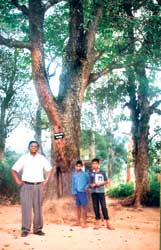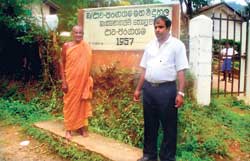
Torture tree of the British Army?In commemorating our Independence it is fitting that we remember these simple village folk who were in the forefront of the Rebellion and were subject to eventual lynching at the 'Tree'. Perhaps it is time a monument is installed here so that the schoolchildren may remember their ancestors in solemn mediation particularly on Independence Day. The potholed road from Uva Paranagama winds its way through paddy and vegetable plots and after a distance of nine km - a half hour journey - reaches Uva Paranagama Maha Vidyalaya. It is rather puzzling to imagine how such a peaceful place could ever have been used as a torture chamber run by the British Army in the early 19th Century. In the olden days this village was known as Paranagama and was an important milestone on the Kandy- Badulla pathway through Udukinda. Obviously geographical necessity led the British to establish a military post here and this hillock would have been chosen as it is strategically the best place to fend off an invader. This was amply proved in the first few months of the Uva-Wellassa Rebellion of 1817/1818.
Ven. Maturata Indasara Thera is a typical village priest who has done yeoman service to the community, quite apart from ministering to the people's spiritual needs. On his initiative, a school was started in 1957 with 11 students and one teacher in his temple, which adjoins the school. The temple dates back to 1889. Today the school has 600 students on roll and a staff of 37. The first to realize the gravity of the 1815 Convention were the signatories themselves, the Kandyan chiefs. They had been absolute rulers subject only to the authority of the King, who did not hesitate to punish any of their oppressive acts. This was the undoing of the last King, in particular, as history reveals. The Rebellion of 1817 was undoubtedly of the chiefs' making. It ignited in remote Wellassa when Muttu Hadji Muhandiram of Kotabowa was scouring the interior to apprehend the Pretender to the Throne, a born- again Doreisamy claiming to be the third in line to the last King. There is historical evidence to support the theory of a torture chamber in Paranagama. During the Uva-Wellassa Rebellion, Major MacDonald was Commandant Badulla when Asst. Resident Sylvester Douglas Wilson was shot with arroweds and killed by Bootave Ratey Rala and others at Yalkumbura near Bibile. Wilson's death on October 16, 1817 made the British reshuffle and hone their military machine.
On October 30, Colonel Kelly was posted to Badulla from Kandy and Major MacDonald from Badulla to Kotabowa/ Wellassa. The Paranagama Post was named after him. At Badulla, Kelly had 271 European and 456 native troops as against 339 European and 773 native troops at Kandy, reinforcements having arrived from Galle, Matara and Hambantota. The Kings of old did not have standing armies. It was invariably a people's militia which could be mobilized when necessary. The militia never gave battle or stood and fought to be defeated. They dealt in devastating ambushes and were masters in guerrilla warfare. The European soldiers had to face severe privation due to difficult terrain, adverse weather conditions, rebel action, ambushes and disease. Normal food was a luxury. Their daily ration was ¼ pound of salted beef and ½ seer of rice in husk. Clearing the husk was agony. Obviously this led them to plunder what little the poor villagers had. Their privation was avenged on the hapless Kandyans who had to carry the loot into the fort, do any menial jobs and be subject to torture and finally be lynched on 'the Tree'. At one corner of the perimeter was a tamarind tree which is now 190 years old, and still stands, bearing a bountiful harvest. The girth of this tree is about 11 feet and Director General of the Botanical Gardens at Peradeniya Dr. Cyril Wijesundara confirms that it could be more than 190 years old. Lynching was prevalent in most civilized societies and decapitating body organs or impaling were not the making of individual Sinhala Kings. Even though the Ehelepola case turned out to be a severe indictment on King Sri Wickrema Rajasingha, it was the custom prevailing at that time. A Mara tree of the same age and girth as the tamarind tee can be seen at one end of the playground, presumably planted by the British. There is also evidence of a dilapidated rampart at the extreme end of the playground where the original fortress would have stood. In commemorating our Independence it is fitting that we remember these simple village folk who were in the forefront of the Rebellion and were subject to eventual lynching at the 'Tree'. Perhaps it is time a monument is installed here so that the schoolchildren may remember their ancestors in solemn mediation particularly on Independence Day. By February 1818, the situation was very grave. All posts in Uva Wellassa were abandoned except those required to preserve communication between Badulla and Batticaloa. Bathurst, Brownrigg's superior in London, in fact, gave orders to give up Kandy and fall back to the maritime provinces in order to save European lives. But Brownrigg was a man of steel who circumvented even his superior and got help from Madras in time to crush the Rebellion. The troops despatched by Sir Richard King from India under Brigadier Shuldham was the watershed which snatched a near victory from the rebels. Brownrigg once said of the Kandyan chiefs, "They are broken into parties which will never unite to resist a government of any energy or strength". Had not Molligoda, Ehelepola, Ekneligoda and Mahawalatenna been with the British, the rebels could have wreaked havoc on the British troops. On the other side of the coin were some really heroic and chivalrous characters. The fact that the British treated Keppetipola, Pilimathalawa, Madugalle, Kivulegedera and Ellepola as the real leaders of the uprising was enough testimony of this. Keppetipola and his comrades in arms having sided with the British in 1815 soon switched allegiance and lost virtually everything except their spirit and valour. Keppetipola was the supernova of the Rebellion. His odyssey came to an end on October 28 when he, Pilimathalawa and Madugalla were captured by Lieutenant O'Neill in Nuwarakalawiya. Kivulegedera was captured on November 20, 1818 in Bintenne. The capture of the Sacred Tooth Relic quite by accident on November 2, 1818 marked the end of the Rebellion. At Fort MacDonald the only recorded incident involving Keppetipola Dissawa took place in February/ March 1818. On February 28, 1818, at daybreak, Keppetipola led a force of about 5,000 to 6,000 men and attacked Fort MacDonald at Paranagama. The Major had only 80 men to fight the rebels. The brave Sinhala hero kept up the attack till March 7 and then dispersed due to some unknown reason. Had he continued the siege, MacDonald would have put up the white flag for the simple reason that there was hardly any food and drink left inside. Davy estimated total rebel casualties at over 10,000 dead. British casualties were around 900 dead, suffering as much from the vagaries of the weather and disease as from action. |
|
||||||
|| Front
Page | News | Editorial | Columns | Sports | Plus | Financial
Times | International | Mirror | TV
Times | Funday
Times | Kandy
Times || |
| |
Reproduction of articles permitted when used without any alterations to contents and the source. |
© Copyright
2008 | Wijeya
Newspapers Ltd.Colombo. Sri Lanka. All Rights Reserved. |

